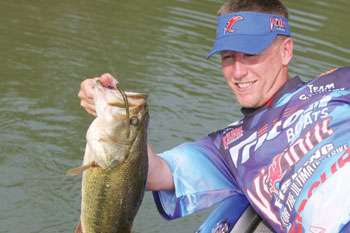
Bassmaster Elite Series angler Jeff Reynolds is a meat-and-taters kind of guy. He's an Oklahoma cowboy who listens to George Strait, deer hunts when he's not fishing and loves flipping a jig.
Not someone you expect to see fishing finesse worms on spinning rods.
"I do now," says the lanky, likable Platter, Okla., pro. "And I enjoy it."
The reason, of course, is he's discovered how deadly shaky worm fishing can be on some deep clear lakes and when conditions are tough.
"It's not always a big fish slugfest on the Bassmaster Tour," Reynolds says. "There are days when the shaky worm may be the very best method for catching fish that will win the tournament."
His shaky head rig consists of a 4 1/2-inch Zoom Finesse Worm fashioned weedless on a 1/16- to 1/4-ounce jighead, 8-pound Vicious Fluorocarbon line and a 7-foot medium action Carrot Stix rod.
The technique gets its name from the way the lure is fished. Once the bait is on bottom, the angler jiggles the rod tip gently to cause the worm tail to vibrate without causing the bait to hop or skip over the bottom. The tantalizing tail action makes the lure look natural and triggers strikes from inactive fish.
Reynolds says his ego prevented him from utilizing the technique until his first year as a Bassmaster pro at a tournament on Table Rock Lake. He had a poor practice while others were catching fish on light tackle.
"I had to borrow a couple of spinning rods from a buddy at the tournament and it didn't go well," he recalls. "I went back to Oklahoma and told (fellow Elite Series pro) Jeff Kriet to teach me."
They went to Lake Murray, Okla., and rigged up finesse worms on shaky heads, and Reynolds has been a believer ever since.
"It was like taking a kid fishing for the first time," Reynolds jokes. "I caught on quickly, and it's now a key part of my arsenal."
In fact, when the Elite Series returned to Table Rock, Reynolds finished fifth — on a shaky worm fished with 8-pound line and a spinning outfit.
Today, he turns to the rig just about anywhere the bite is tough.
"It's a limit-finder kind of technique, but it catches big ones, too," he says. "I've caught 7-pounders on it."
Here's a look at his tips for shaky worm fishing.
Seasonal patterns: Prespawn is about the only time he won't use it because the fish are usually aggressive and other baits can be worked more quickly.
"But when you get into postspawn and the fish are finicky or aren't in a chasing mood, it's an excellent choice," he insists.
When bass get on points and ledges during the summer, the shaky worm is a good follow-up bait.
"If I go through an area and catch them on a Carolina rig, jig or crankbait, I will make one more pass with the shaky worm and catch fish that didn't bite the bigger baits."
He admits it may not be the best choice in the fall when bass move into creeks to feed up prior to winter.
"But if those fish get on dock posts that can't be reached with other lures, try skipping the shaky head back there," Reynolds says.
Once the water cools heading into winter, fishing shaky heads on deep docks gets even better.
"The water never gets too cold for a shaky head," he adds.
Fish "hard" cover: The shaky worm is best known for fishing rock ledges, gravel points and docks, but it works around wood, too. Reynolds will pitch the shaky worm around sparse brush, off the ends of fallen trees and against standing timber.
"Bass will suspend around all of those, and the slow fall will get you those bites that other lures won't," he describes. "That's another reason for fishing a spinning rod — the bait falls vertically. If you use a baitcast outfit, it tends to fall back toward you."
Color choices: Go natural, Reynolds says, choosing worm colors that blend in with the environment. Green pumpkin for stained water and watermelon candy for clearer water are his favorites.
"On dark days, even in clear water, dye the worm tail chartreuse," he suggests.
Jighead selection: Reynolds is very choosy about the jig he uses. Because few manufacturers make one with a light wire hook, he uses a homemade version with a 3/0 Gamakatsu wire version.
Light wire hooks penetrate the worm more easily, he says, requiring less force to set the hook, which is imperative when fishing light line.
"I also don't like jigheads that have a screw coming out of the head, designed to hold the worm in place," he offers. "In my opinion, you don't get as good of a hook set."
SPOOLING LIGHT LINE
Large arbor reels with good drags are best when using light line. Regardless of the brand of reel, make certain the drag is smooth and will not stick. A stuck drag is the easiest way for a nice bass to swim away with your shaky head in its lip. Instead of spooling these reels entirely with thin diameter line (some reels would require 400 yards of 6-pound-test to fill the spool), use a 10- to 12-pound-test backing.
Once your spool is halfway full of the heavier line, connect the lines with a blood knot or triple surgeon's knot and reel on about 100 yards of 6- to 8-pound test. Bassmaster Elite Series pro Jeff Reynolds prefers 8-pound Vicious Fluorocarbon. And because light lines have a tendency to kink and coil, replacing only 100 yards is an easy task.

